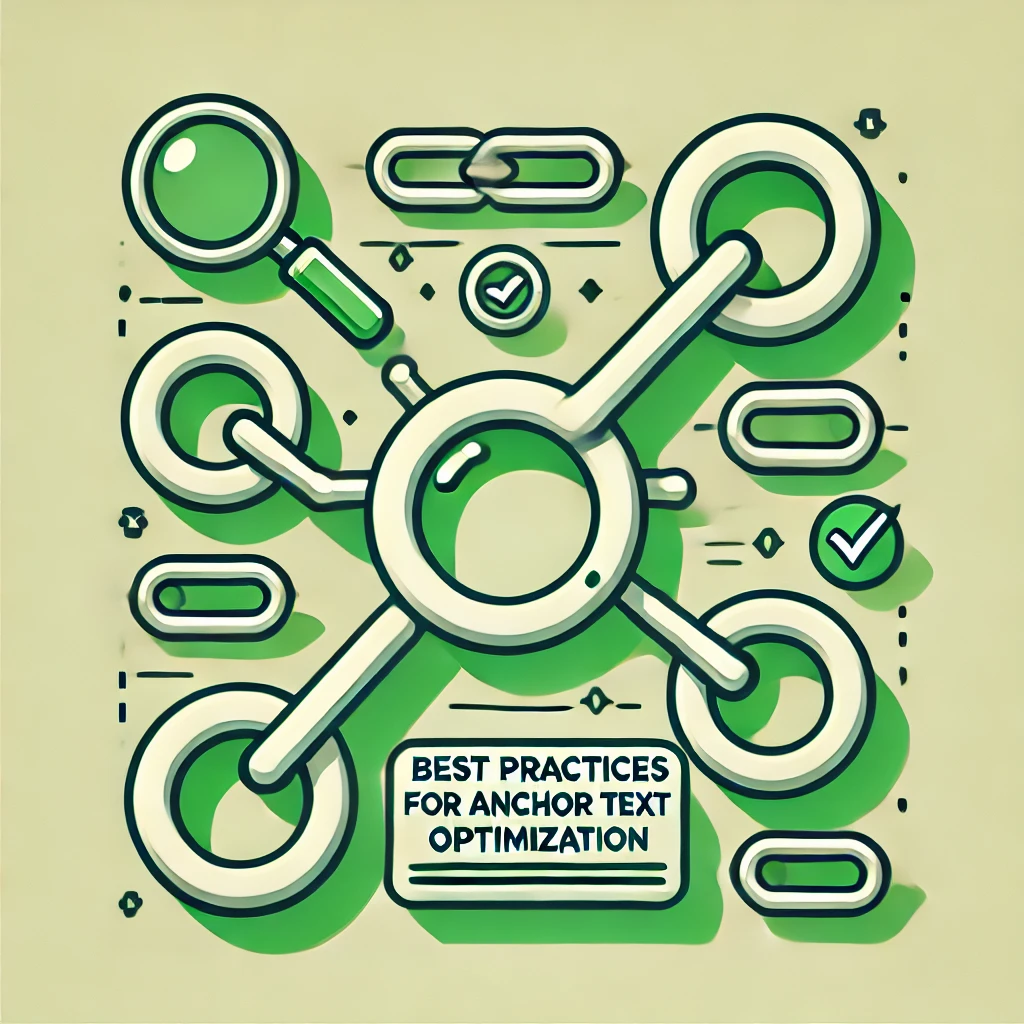In the SEO world, anchor text is a small detail that can make a big difference. The right anchor text can improve your search engine rankings and attract more visitors. But how do you know which words to hyperlink and how to use them effectively?
Anchor text tells search engines what your linked page is about. If done right, it can help your site rank higher for specific keywords. You want to balance relevance and variety, ensuring each link looks natural and useful to search engines and readers.
Mastering anchor text strategy means paying attention to both content and context. It’s not just about stuffing keywords but using them thoughtfully. This blog will guide you through understanding and using anchor text to your advantage in link building.
Key Takeaways
- Anchor text helps improve search engine rankings.
- Balance relevance and variety in your link strategy.
- Thoughtful use of anchor text enhances SEO results.
Understanding Anchor Text in SEO
Anchor text is the clickable text in a hyperlink. It is important for SEO because it helps search engines understand what the linked page is about. Different types of anchor text can impact your SEO strategy differently, and search engines consider anchor text when ranking your site.
Defining Anchor Text
Anchor text is the visible, clickable text in a link. It usually appears in a different color and is sometimes underlined. For example, in the sentence “Learn more about SEO,” the word “SEO” is the anchor text. This clickable text directs users to another page.
Using relevant and clear anchor text helps users and search engines understand the linked content. This improves the user experience and can aid in better search engine rankings.
Types of Anchor Text
There are several types of anchor text, including:
- Exact Match: Contains the exact keyword you want to rank for.
- Partial Match: Includes a variation or part of the target keyword.
- Branded: Uses your brand name.
- Naked URLs: The URL itself, like www.example.com.
- Generic: Phrases like “click here” or “read more.”
- Images: The alt text of an image used as a link.
Using a mix of these types can create a natural link profile. Avoid overusing exact match anchor text, as it may seem spammy to search engines.
Role in Search Engine Algorithms
Search engines like Google use anchor text as a ranking signal. When many links point to a page with relevant keywords in the anchor text, search engines consider that page more relevant for those keywords.
Search engines also look for natural usage of anchor text. If your site only has exact match anchor texts, it might flag it for unnatural linking. Various anchor text types signal a more organic and credible link profile.
By paying attention to anchor text types and usage, you can improve your link building strategy and SEO performance.
Establishing Relevance with Anchor Text
Using anchor text effectively boosts your website’s relevance and ranking in search engines. It ensures that the anchor text relates closely to the linked content and the surrounding text.
Contextual Relevance
Contextual relevance means the anchor text should fit naturally within the surrounding content. Search engines look at the context to determine if the link is valuable and related to the topic.
For example, if you’re writing about “healthy diets,” an anchor text like “nutrient-rich foods” is better than “click here.” The anchor text should make sense in the sentence and enhance the content.
Avoid using generic phrases. Opt for specific keywords that match the content of the linked page. These keywords help search engines understand the linked content and improve your site’s SEO.
Content and Anchor Text Alignment
Your anchor text should match the content of the linked page. If the anchor text says “high-protein recipes,” the link should lead to a page about recipes with high-protein content.
This alignment ensures visitors find what they expect, keeping them on your site longer. It also helps search engines index your site accurately, improving your search rankings.
You need to review both the anchor text and the linked content. Ensure they are consistent and relevant to each other to maximize the effectiveness of your link building strategy.
Strategizing Anchor Text for Link Building
When planning your anchor text strategy, focus on using a variety of anchor texts and placing them strategically within your content for maximum impact.
Diversity and Distribution
Using a mix of anchor text types is crucial. Exact match anchor text includes your target keywords. Partial match contains your keywords plus other terms. Branded anchor text uses your brand name.
Here is an example breakdown:
| Anchor Text Type | Example |
| Exact Match | “SEO tips” |
| Partial Match | “read SEO tips here.” |
| Branded | “OpenAI website” |
| Generic | “click here” |
| Naked Link | www.example.com |
Distribute these types to avoid over-optimizing. Use each type naturally within your content. Overusing exact matches can make your site look suspicious to search engines. Aim for a balance to enhance credibility.
Anchor Text and Link Placement
Where you place your anchor text matters. Links in the main content hold more value than those in the footer or sidebar. Keep your anchor text relevant to the linked content.
Make your anchor text stand out. Use bold or italics if they fit naturally for link placement position links in the introduction and within the body text for better engagement and SEO value. Ensure that every link provides real value to the reader and aligns with the content’s context.
By strategically placing anchor text, you increase the chances of it being clicked and recognized by search engines.
Best Practices for Anchor Text Optimization
Effective anchor text optimization can boost your SEO efforts. Focus on avoiding over-optimization and naturally integrating anchor text within your content for the best results.
Avoiding Over-Optimization
Using the same anchor text repeatedly can harm your SEO. Search engines might see it as spammy. It’s better to vary your anchor text. Use a mix of exact match, partial match, and branded keywords.
For instance, if “best shoes” is your keyword, alternate with phrases like “top shoes” or “best footwear.” This makes your content look more natural to search engines.
Also, avoid stuffing your content with keywords. It should naturally fit within your content and provide value.
Natural Integration in Content
Anchor text should fit into your content seamlessly. It should provide valuable context for the linked page. Avoid forcing keywords into your text.
Use anchor text where it makes sense. For instance, in a sentence about hiking gear, link naturally with “best hiking shoes” instead of awkwardly adding “best shoes for hiking.”
Use synonyms and related terms to vary your anchor text. This helps to diversify your links and keeps your content engaging for readers.
The Risks of Improper Anchor Text Usage
Using anchor text incorrectly can lead to serious problems for your SEO efforts. These issues can range from Google penalties to poorer search engine rankings.
Google Penalties
Improper use of anchor text can attract penalties from Google. Keyword stuffing, which involves overusing the same anchor text repeatedly, can trigger this. Google sees this as an attempt to manipulate search rankings.
Anchors that seem unnatural can also lead to penalties. If it feels forced or repetitive, Google might flag it. Using varied and context-appropriate anchor texts helps avoid this.
Think about quality over quantity. More low-quality backlinks with good anchor text can help your site. Balance is key. Always aim for natural, relevant links that fit within the content.
Tools and Techniques for Anchor Text Analysis
Effective anchor text analysis can help you improve your SEO efforts and outperform competitors. Here, we look at key tools and proven strategies.
Analytical Tools Overview
Several tools make it easier to analyze anchor texts. Ahrefs and SEMrush are popular choices. These tools allow you to see different anchor texts’ distribution, frequency, and effectiveness. You can identify which anchor texts bring in the most traffic.
Google Search Console is another essential tool. It shows you which keywords are linked to your pages and how they perform in search rankings. This helps you adjust your anchor text strategy based on actual data.
Some key features to look for in analytical tools include:
- Anchor text distribution reports
- Keyword performance data
- Competitor analysis capabilities
Competitor Anchor Text Strategies
Understanding how your competitors use anchor texts can provide valuable insights. Tools like Moz and Majestic SEO offer competitor analysis features. You can see the anchor texts they use most frequently and identify patterns or trends in their strategy.
Look for:
- Common keywords in their anchor texts
- The types of content they link to
- The context in which anchor texts are used
By studying these aspects, you can adopt successful strategies and spot weaknesses in your competitors’ approaches. This information can guide you in creating a more effective and competitive anchor text strategy.
Evolving Practices in Anchor Text Strategy
The practices for anchor text strategy are continuously changing with search engine algorithm updates and emerging trends. It’s key to know how to adapt.
Keeping Up with Algorithm Updates
Search engine algorithms change often. These updates can have a big impact on how you use anchor text. Search engines like Google aim to stop spammy practices. People used exact match anchor text to rank higher in the past. Now, using exact matches can help your site’s ranking.
Focus on diverse anchor text. Use a mix of exact match, partial match, branded, and generic text. This variety makes your links look natural. Also, context matters. Ensure the surrounding text is relevant to the link. Tools like Google Search Console can help monitor performance and detect issues.
Avoid keyword stuffing in links. It’s better to use keywords naturally. Keep an eye on algorithm updates to adjust your strategy as needed.
Future Trends in Anchor Text Usage
Future trends suggest a shift towards user-focused strategies. The quality and relevance of content around anchor text will be crucial. Voice search is on the rise, changing how users find information. Your anchor text should adapt to natural language patterns in voice queries.
Consider using conversational keywords in your anchor text. This aligns with how people speak and search. Semantic search is another trend. Search engines understand the meaning behind queries better. Use related keywords that provide context.
Expect stricter measures against manipulative practices. Prioritize user experience over trying to game the system. Stay informed about new tools and techniques to keep your strategy effective in the changing landscape.
Frequently Asked Questions
This section answers common questions about anchor text strategy for SEO link building, covering best practices, impacts on rankings, penalties, effectiveness measurement, and risks.
What are the best practices for choosing the right anchor text for SEO link building?
Choose anchor text that is relevant to the content it links to. Use keywords naturally and avoid overstuffing. Diversify your anchor text using exact match, partial match, branded, and generic text.
How does anchor text variety impact search engine ranking?
Variety in anchor text helps create a natural link profile. Use a mix of exact match, partial match, branded, and generic text signals to search engines that your link building is authentic. This can improve search engine rankings and reduce the risk of penalties.
What is the role of exact match anchor text in modern SEO?
Exact match anchor text uses keywords that precisely match the targeted search query. While it can help improve rankings for specific keywords, it’s important to use it sparingly. Overuse can lead to penalties from search engines.
Can over-optimization of anchor text lead to penalties from search engines?
Yes, over-optimization occurs when anchor text is excessively keyword-rich or repetitive. This can trigger search engine algorithms to flag your site for manipulative link building practices, leading to ranking penalties.
How can one measure the effectiveness of anchor text strategy in link building campaigns?
Track metrics like referral traffic, search engine rankings, and conversions. Use tools like Google Analytics and Ahrefs to monitor link performance. Analyzing changes in keyword rankings and site traffic can help assess the impact of your anchor text strategy.
What are the potential risks of using generic anchor text for SEO purposes?
Using generic anchor text like “click here” or “read more” can dilute the relevance signal to search engines. This makes it harder for search engines to understand the link’s context. As a result, it may need to contribute more effectively to SEO efforts.





